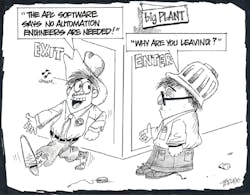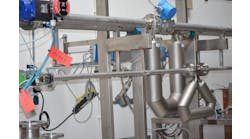This Control Talk column appeared in the May 2018 print edition of Control. To read more Control Talk columns click here or read the Control Talk blog here.
Greg: Advanced process control (APC) is on the verge of resurgence because of the increased capability of today’s digital control systems for advanced regulatory control (ARC) that offer inherent structural advantages, ability to reject load disturbances, inclusion of soft sensors, proven functionality developed by key experts, and procedure automation (state-based control). In the ISA 2017 Process Control & Safety Symposium panel on APC with Dr. James R. Ford, senior consultant at Maverick Technologies, I was impressed with his ARC knowledge that was in synch with my experience. Here we gain insight to the best APC by ARC.
Jim, what is the starting point to understanding the ARC’s successful history?
Jim: Automatic process control was initially developed to respond to unmeasured disturbances. The development of the automatic control valve ushered in the era of modern process control. The first truly automatic control valves were developed to replace manual valves to control flow. The flow control loop has become the foundation of all automatic process control, for several reasons.
Unlike pressure and temperature, which are intensive variables, flow is an extensive variable. Intensive variables are key control variables for stable operation of process plants because they relate directly to composition. Intensive variables are usually controlled by adjusting flows, the extensive variables. In this sense, intensive variables are higher in the control hierarchy. This explains why a simple cascade almost always involves an intensive variable as the primary and flow as the secondary. When a pressure or temperature controller adjusts a control valve directly (rather than the flow in a cascade), the controller is actually adjusting the flow of material through the valve. What this means, practically, is that, unlike the intensive variables, a flow controller has no predetermined or “best” target for any given desired plant operation. The flow will be wherever it needs to be to maintain the higher-level intensive variable at its best value.
The above comments apply to almost all flow controllers, even important ones like the main unit charge rate controller. The target for this control will be adjusted to achieve an overall production rate, to push a constraint, to control the inventory of feed (in a feed drum), etc.
Greg: What about additional feed flows, such as flow of solvent in an absorption or extraction process?
Jim: In this case, there is a more important, higher-level control variable, an intensive variable, namely, the ratio of the solvent to the unit charge rate. The flow of solvent will be adjusted to maintain a “best” solvent/feed ratio.
For temperature, and especially pressure, these loops are tuned as tightly as possible to react to disturbances. This is because intensive variables are directly related to composition, and good control of composition is essential for product quality and yield. However, if the operator makes an setpoint (SP) change, a much less “aggressive” control action is preferred. This is because the resulting composition change will induce disturbances in other parts of the process, and the goal is to propagate this disturbance as smoothly as possible, so as to allow other loops to react without significant upset.
The other major type of disturbance is measured. Common examples are changes in charge rate, cooling water temperature, steam header pressure, fuel gas header pressure, heating medium temperature and ambient air temperature, etc., where instruments are installed to measure those variables. The first 20 years of developing APC technology focused primarily on using measured disturbance information for improving the quality of control. Why? Modern process units are complex and highly interactive. The basic control system, even a modern DCS, is incapable of maintaining fully stable operation when disturbances occur. APC was developed to mitigate the destabilizing effects of disturbances, and thereby to reduce process instability. This is still the primary goal of APC. Any other claimed objective or direct benefit is secondary.
Why is it so important to reduce process instability? Process instability leads to extremely conservative operation so as to avoid the costly penalties associated with instability, namely, production of off-spec product and violation of important constraints related to equipment life and human safety. Conservative operation means staying well away from constraint limits. Staying away from these limits leaves a lot of money on the table in terms of reduced yields, lower throughput and greater energy consumption. APC reduces instability, allowing for operation much closer to constraints, thereby capturing the benefits that would otherwise be lost.
The main techniques for improving the control system’s response to measured disturbances were called feedforward, compensating and decoupling. In the example of a fired heater mentioned earlier, adjusting the fuel flow for changes in heater charge rate and inlet temperature is feedforward. The objective is to head off upsets in the heater outlet temperature that are going to occur because of feed rate and feed temperature changes. In similar fashion, the fuel flow can be compensated for changes in fuel gas header pressure, temperature, density and heating value, if these measurements are available. Finally, if this is a dual-fuel heater (e.g., fuel gas and fuel oil), the fuel gas flow can be adjusted when the fuel oil flow changes, so as to decouple the heater from the firing upset that would otherwise occur.
This decoupling is often implemented as a heater fired duty controller. A second area of initial APC development effort focused on controlling process variables that are not directly measured by an instrument. An example is reactor conversion or severity. Hydrocracking severity is often measured by how much of the fresh feed is converted to heating oil and lighter products. If the appropriate product flow measurements are available, the conversion can be calculated and the reactor severity can then be adjusted to maintain a target conversion. Work in this area of APC led to the development of a related body of engineering technology referred to as “inferred properties” or “soft sensors.”
Greg: It has been proven that for unmeasured disturbances, no other algorithm can do better than PID. Model predictive control (MPC) does not do as well because it is essentially integral-only control via a bias correction over its time horizon, lacking the benefits of proportional and derivative modes, particularly for lag-dominant processes. Also, flow ratio control is critical in many unit operations, especially reactors and columns. MPC lacks this fundamental capability. Columns are often started up on local flow ratio control with a ratio set by the operator until the temperature is representative of composition. For more details on the practical considerations, see my Control Talk blog, “Uncommon Knowledge for Achieving the Best Feedforward and Ratio Control.”
Jim: Intensive variables call for a different closed-loop response for process variable (PV) changes due to disturbances versus SP changes. Modern digital control systems can provide some help in this area. For example, the control loop can be configured to take proportional action on PV changes only, ignoring the effect of SP changes. Then, following an SP change, integral action will grind away on correcting the offset between SP and PV. However, these features do not fully correct the deficiency discussed above. This dilemma plagues control systems to this very day, and is a major justification for implementing advanced controls that directly address this and other shortcomings of basic process control.
We have been particularly successful in this area with development of our “smart” PID control algorithm. In its simplest form, it addresses the biggest weakness of PID, namely, the overshoot that occurs because the algorithm continues to take integral action to reduce the offset between SP and PV, even when the PV is returning to SP. Our algorithm turns the integral action on and off according to a proven decision process made at each controller execution. This algorithm excels for lag-dominant and deadtime-dominant loops. We use this algorithm on virtually all APC projects.
Greg: In his books, Greg Shinskey has shown how you can use a setpoint lead-lag to enable a good SP response with tuning for maximum rejection of load disturbances. He also shows how external reset feedback (ERF) of the manipulated variable (e.g., flow) can eliminate oscillations from slow secondary loops or slow valves. Furthermore, the insertion of a deadtime block in the ERF path can provide performance better than a Smith Predictor or MPC. I have expanded the ERF potential opportunities to include directional move suppression to prevent upsets to other loops, prevent unnecessary crossings of the split-range point, and provide a smooth approach to an optimum and fast getaway for valve position controllers as detailed in the Control article, “Don’t over look PID in APC." ERF has also been extended to prevent oscillations and eliminate retuning for wireless and analyzer applications where the update time and sample time exceeds the 63% process response time. This relatively new ERF-derived capability was detailed in the InTech article, “Wireless - Overcoming challenges in PID control & analyzer applications” and misunderstandings about PID control addressed in the Control article “Common automation myths debunked.” Shinskey was the leader in maximizing the PID capability as detailed in the Control article, “The greatest source of process control knowledge.”
What is the structural advantage of ARC?
Jim: Prior to MPC, the most successful APC engineers used a process engineering-based, hierarchical approach in developing ARC solutions. At the bottom of the control hierarchy, its foundation is what we referred to as basic process control, the single and simple cascade loops that appear on P&IDs and provide the operator with the first level of regulatory control. The hierarchical approach to ARC design identifies the causes of the disturbances in each part of the process, then layers the solutions that deal with the disturbances on top of the basic control system, from the bottom up. Each layer adds complexity and its design depends upon the disturbance(s) being dealt with.
Greg: The ARC hierarchical approach is more understandable by operators and by process and automation engineers, enabling a synergy. Consequently, the resulting APC has a greater onstream time, and is more amenable to continuous process control improvement. What is a good example?
Jim: Consider the classic problem of how to control the composition of distillation tower product streams, such as the overhead product stream. The hierarchical approach is based upon identifying and dealing with the disturbances. The first type of disturbance that typically occurs is caused by changes in ambient conditions (air temperature, rainstorms, etc.), which lead to a change in the temperature of the condensed overhead vapor stream, namely the reflux (and overhead product). This will cause the condensation rate in the tower to change, leading to a disturbance that will upset column separation and product qualities.
Hierarchical APC design deals with this disturbance by specifying, as the first level above basic control, internal reflux control (IRC). The IRC first calculates the net internal reflux with an equation that includes the heat of vaporization, heat capacity and flow of the external reflux, the overhead vapor temperature and the reflux temperature. The control next back-calculates the external reflux flow required to maintain constant IR, and then adjusts the setpoint of the external reflux flow controller accordingly. This type of control provides a fast-responding, first-level improvement in stability by isolating the column from disturbances caused by changes in ambient conditions.
There are multiple inputs to the control (the flow and temperatures which contribute to calculation of the internal reflux), but typically only one output – to the setpoint of the reflux flow controller. Moving up the hierarchy to the ARC level, the overhead product composition can be further stabilized by controlling a key temperature in the upper part of the tower, since temperature (at constant pressure) is directly related to composition. And, since the tower pressure could vary (especially if another application is attempting to minimize pressure), then the temperature that is being controlled should be corrected for pressure variations. This control adjusts the setpoint of the IRC to maintain a constant pressure-corrected temperature (PCT). Feedforward action (for feed rate changes) and decoupling action (for changes in reboiler heat) can be added at this level.
To summarize, some of the important advantages of this approach are:
- Operators can understand the strategies: They appeal to human logic because they use a “systems” approach to problem-solving, breaking a big problem down into smaller problems to be solved.
- The control structure is more suitable for solutions at a lower level in the control system. Such solutions can often be implemented without the requirement for additional hardware and software.
- The controls “degrade gracefully:” When a problem prohibits a higher-level APC from being used, the lower level controls can still be used and can capture much of the associated benefit.
- Just dump all of your operating data into the software
- You don’t need a person who understands the process.
- You don’t need anyone who is proficient in process control.
- The software will setup a matrix that spans the whole plant, including every process input and output.
- You don’t need flow ratio control or PID control.
- Any old valve will do.
- Operators do not need to be involved or trained.
- Plant testing is not required.
- We don’t offer onsite support.
- Trust us, the software does everything.







